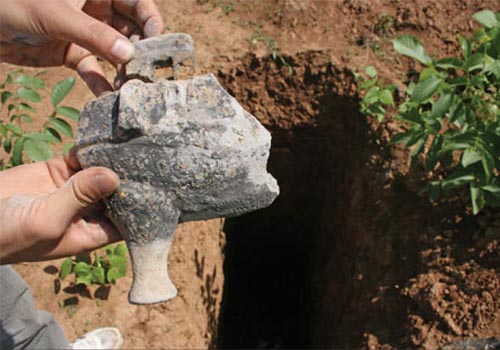Society
Tomb raiders remain a menace
Updated: 2011-09-09 14:26
By Zhang Yan (China Daily European Weekly)
|
 Several holes left behind by tomb raiders are exposed in cornfields in Chengguan town of Luonan county, Shaanxi province, on July 8. Pottery fragments and broken pieces of a wooden coffin were found near the holes' entrances. [Provided to China Daily] |
Professional criminals target vulnerable and valuable cultural treasures
Despite increasing efforts to tackle the illegal traffic in cultural artifacts, every year thieves break into tombs and steal priceless treasures. These thefts endanger China's cultural heritage as never before, said Wei Yongshun, a senior officer from the Ministry of Public Security's criminal investigation bureau. "Sheer greeds are behind these crimes," Wei said.
Police investigated 973 cases in 2010 involving cultural artifacts. Of these, 451 related to tomb raids and 387 to theft. From January to June 2010, authorities smashed 71 gangs, detained 787 suspects and recovered 2,366 artifacts, according to ministry figures.
Wei said most tomb raids are committed by gangs, which are much more organized than individuals, and have the means to easily dispose of their loot.
He said the members of these sorts of gangs often have specialties.
"Usually a gang leader stays behind to fund the whole operation, and a special technical advisor finds and blows up a tomb site," he said. "They often also hire groups of professional grave robbers to carry out a crime."
Advanced technology is also used. Tomb raiders have been known to employ explosives, walkie-talkies, night-vision goggles, various lights, oxygen canisters, antiviral masks, and various devices used to find the locations of tombs, the ministry official said.
After a tomb has been looted, a gang boss will usually pay the grave robbers he has hired and then try to sell the artifacts immediately or to smuggle them overseas.
"The gangsters almost always use fake names and kept the artifacts they had stolen in their hands for a short time," Wei said. "That has added to the practical difficulty of finding and getting these stolen items back."
Making matters worse, Wei said, is the fact that local governments are at times indifferent to these types of crimes or are too weak to prevent them.
Wei said tomb raiders often use online technology, such as instant messaging and e-mails, to trade with buyers of rare cultural artifacts.
"The Internet is a place where the judging and ordering of samples, discussions about prices and payment transaction can all occur," Wei said.
In recent years, the traffic in cultural artifacts has accelerated and has begun to take place in ever more clandestine ways, he said.
"These sorts of criminals have shown ingenuity by illegally buying or trafficking cultural artifacts under the guise of managing antique shops or selling used goods," Wei said. "Flea markets have also become places where artifacts either are sold or taken to be smuggled out of the country."
Chinese gang leaders have also been known to work with overseas traffickers, and sometimes customs officials fail to prevent such items from leaving the country, he said.
"Stolen cultural artifacts are usually first smuggled out through Hong Kong and Macao and then taken to Taiwan, Canada, America or European countries to be traded," he said.
E-paper

Way over the moon
High inflation rockets mooncake prices out of orbit for mid-autumn festival
From death matches to child's play
Tomb raiders remain a menace
Kicking for joy
Specials

Singing success
Western musicians bring much-needed impetus to live performance industry

Salary bonanza for bosses
Top boss gets 8.78 million euros a year, far more than the State enterprise CEO with highest pay

Kicking for joy
Swedish college student represents China in Taekwondo championships
